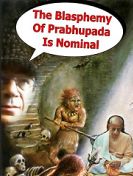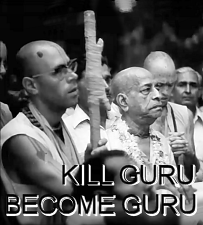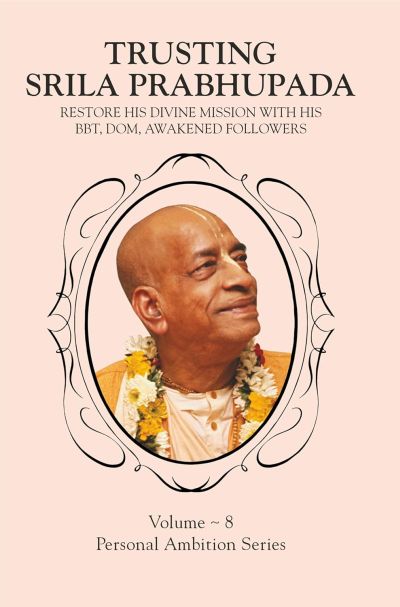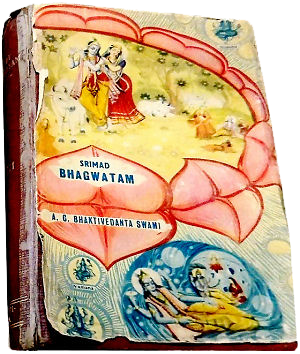 Gauridasa Pandita Dasa: Sri Ramanujacarya is one of my favorite devotees outside our Brahma Madhva Gaudiya Sampradaya. He is in the Sri Sampradaya, Goddess Laxmi, one of the four bonafide disciplic successions. When devotees are initiated today they are still disciples of Sri Ramanujacarya because he gave the main teachings and is the main Acarya in that line. Here is some nectar about the history of Sri Ramanujacarya.
Gauridasa Pandita Dasa: Sri Ramanujacarya is one of my favorite devotees outside our Brahma Madhva Gaudiya Sampradaya. He is in the Sri Sampradaya, Goddess Laxmi, one of the four bonafide disciplic successions. When devotees are initiated today they are still disciples of Sri Ramanujacarya because he gave the main teachings and is the main Acarya in that line. Here is some nectar about the history of Sri Ramanujacarya.
Sri Ramanujacarya appeared around 1017 A.D in a pious brahmana family. He became the formost Acarya in the Sri Sampradaya and was reputed to be the incarnation of Laksmana, the younger brother of Lord Ramacandra.
He was a boy of extraordinary intelligence and placed himself under the charge of Yadavacarya, a renown Sankarite scholar. His guru was struck with his marvelous intellect and became very uncomfortable on account of his firm faith in Bhakti.
One day while taking a massage, Yadavacarya was explaining to Ramanuja a sutra “tasya yatha kapyasam pundarikamevamaksini” (Chandogya 1.6.7), saying that according to Sankara, the two eyes of Pundariksa are like two lotuses which are red like the nates of a monkey. On hearing this interpretation with the unbecoming and low simile, Ramanuja’s soft heart, tender by nature and softened by devotion, melted and as he was massaging, tears rolled down from the corners of his eyes like flames of fire and fell on the thigh of Yadava. Looking up at the touch of the hot tears, Yadava understood that something troubled his disciple. Ramanuja explained his dismay at hearing such an unbecoming explanation from his guru. He thought it sinful to compare with the posterior of a monkey the eyes of the Supreme Personality of Godhead – who is endowed with all gracious qualities and who is the repository of all the beauty of the universe. Yadava was angry at the boy’s audacity and told him to explain the verse if he could. Ramanuja analysed the word kapyasam to mean `blossomed by the sun’ and the verse to mean “The eyes of that Golden Purusa are as lovely as lotuses blossomed by the rays of the sun.”
After a few more such incidents when Ramanuja corrected his guru, Yadavacarya thought him to be a threat to the Sankarite line and plotted to kill him. Later it came to pass that Yadavacarya was to become the disciple of Ramanuja.
Yamunacarya, the formost exponant of Vaisnava philosophy of the time, knowing of his extraordinary ability and purity, called for Ramanuja with the intent of placing him in charge of the mission after his disappearance. Ramanuja was on his way to see Yamunacarya when he received the news of Yamunacarya’s departure from the world. Arriving at Srirangam, Ramanuja went to have his last darshana of that great soul. There he noticed three of Yamunacarya’s fingers were clenched. Ramanuja then made three vows: he would make the people surrender to God and initiate them by the pancasamskara – he would write a commentary on the Vedanta sutra which was later called Sri Bhashya – he would also write what is like an encyclopedia on the Puranas and would name one greatly learned Vaisnava after Parasara Muni who wrote the gem among the Puranas, the Visnu Purana.
Later Ramanuja took sannyasa and traveled throughout India vigorously defeating atheists and impersonalists by preaching the Vasistadvaita doctrine. He never failed to win over a rival in spiritual disputations.
His philosophy is visistadvaita. Brahman is Narayana – (cit-acit-isvara), Narayana with Laksmi – (transcendental form), Four Vyuha forms, Vaibhava forms. The qualities of Brahman are both nirguna and saguna. The soul is real, eternal, individual, not omnipresent, not independent of Isvara, but part. Isvara is the efficient cause of creation. It is from His will out of delight. The cause of bondage is beginningless karma. The process of release is Bhakti based on Pancaratra and Visnu purana followed by detached karma that brings jnana – Prapatti. The goal is to attain the same nature of Isvara and companionship with Him. He does not return and has no power of creation, etc.
Once while Ramanuja Acarya was staying in Jagannath Puri he offered prayers to Lord Jagannatha, who became very pleased. Lord Jagannatha appeared before Ramanuja and said, “Ramanuja, go and visit Sri Navadwipa, for very soon I shall appear there in the house of Jagannatha Misra. Sri Navadwipa is My most beloved abode and is a part of the spiritual sky manifest in this world. As my eternal servant and a leader amongst My devotees, you should go there. Let your students stay here, for they are absorbed in dasya rasa (servitorship in awe and reverence) and will not understand the advanced devotional mood, so travel there alone. Any living entity who does not go to see Sri Navadwipa has been born uselessly. Just one portion of Sri Navadwipa contains Ranga Ksetra, Venkatesvara and Yadava Acala. Therefore go to Sri Navadwipa and see My form of Gauranga. After gaining the Lord’s blessing go to Kurma Sthana and rejoin your disciples.”
Folding his hands, Ramanuja humbly requested Lord Jagannatha, “My dear Lord, You have mercifully told me something about Gauranga, but exactly who He is, I do not know?”
The Lord answered, “It is known to you that Lord Sri Krsna, the Lord of Goloka, is the Supreme Absolute Truth. That much is well known to My devotees. That same Supreme Personality of Godhead who resides in Sri Vrindavana is fully manifest as Gauranga, and His beloved abode, Sri Vrindavana, is manifest as the holy land of Sri Navadwipa. Navadwipa is the Supreme spiritual abode and it is transcendental to the influence of the material nature. In that divine land, Lord Gauranga eternally resides. By My mercy that holy abode has come to exist within the universe, but it remains completely unaffected by maya. This is the verdict of the scriptures. If anyone thinks that Sri Navadwipa is only a material location, then whatever devotion he has developed will wither and perish. By My will, My inconceivable energy preserves this transcendental abode within this material world. Simply by studying the scriptures, one will not be able to understand the Absolute Truth. Only by My mercy can My devotees understand.”
Hearing these words of Lord Jagannatha, Ramanuja was filled with love. “My dear Lord,” he said, “Your pastimes are truly astounding. The scriptures cannot fully describe Your opulences. Why is Gauranga-lila not described in the scriptures? Upon reflection, I find some hint of Gauranga tattva in the srutis and puranas. Now, however, all my doubts are gone and I am ready to execute Your will. If it is Your desire, I will go to Sri Navadwipa and from there, I will set out to preach about Lord Gauranga throughout the three worlds, giving evidences from the scriptures to all, converting them to the devotional service of Gauranga. Please instruct me. You have just to give me Your order.”
Lord Jagannatha replied, “Ramanuja, do not broadcast in this way. Keep these secrets of Lord Gauranga’s pastimes as they are for the present. Only after He has concluded His pastimes will the people in general come to understand them. Preach about me on the level of dasya rasa as you have always done, but within your heart, worship Lord Gauranga constantly.”
Following Lord Jagannatha’s order, Ramanuja secretly cultivated his attraction for Sri Navadwipa. Being very merciful, Lord Narayana led him to Vaikunthapura and showed him His transcendental form, worshipped by manifestations of His different energies. Ramanuja felt himself most fortunate to see this, but, as he watched, the Lord manifested His form as Gauranga, the son of Jagannatha Misra. Ramanuja’s mind became stunned by the brilliance of His shining golden form. Lord Gauranga then placed His two lotus feet upon Ramanuja’s head and Ramanuja, filled with inspiration, began to offer prayers.
Ramanuja said, “I must see Your pastimes when You appear here in Navadwipa My Lord. I shall never leave this place.”
Lord Gauranga replied, “Your wish will be fulfilled, O son of Kesava. When My Navadwipa lila is revealed you will again take your birth here.”
Lord Gauranga then disappeared. Greatly satisfied by the Lord’s promise, Ramanuja returned to Kurma Sthana, where he joined his disciples. During his life he preached devotional service to the Lord in the mood of dasya rasa, or servitorship throughout the south of India, whilst internally he was absorbed in meditating on the pastimes of Lord Gauranga. By Lord Gauranga’s mercy, he was born again in Sri Navadwipa as a devotee named Ananta to assist in the Lord’s pastimes. When Lord Caitanya made His appearance in Sri Navadwipa, Ananta Vipra was already quite old, He lived in a cottage which was situated beneath a huge old banyan tree. There, within his humble abode, he would worship his Deities of Laxmi-Narayana. None could describe the pure way in which he worshipped Them.
Once Ramanuja was walking along with his 5 top sannyasi disciples. Stopping by a pond, he took some Prasadam and threw half of it in the water for the fish. Then he got up to walk on. Just then the fish who had taken the prasadam assumed four-handed forms and rose up in the air, returning home, back to Godhead. The 5 sannyasis stopped and begand to disrobe. Ramanuja turned and asked them why they were not following. They said, “We are thunder- struck. Please explain what we have just seen. Otherwise, how can we follow behind you in this condition?” Ramanuja answered, “You’ve seen the power of taking maha-Prasadam.” They answered, “But we are taking your maha-Prasadam daily, and this is not happening to us.” Ramanuja said, “These creatures have no free will, and therefore make no offense. So they get full benefit at once. But you with your free will and human intelligence make offenses, and thus you hinder your own progress.”
Another time Ramanuja was talking with his sannyasi disciples, and they asked him how they would ever be able to understand the deep philosophy he had written. He said, “What I have written ultimately means simply one thing – prapatti (surrender).” But they continued to argue that they would not be able to fully comprehend his writings. Then he told a sannyasi disciple to bring one deaf and dumb tailor who was just walking by. When the man came, Ramanuja asked them all to leave him alone with this man. So they got up and left, but one disciple looked into the room from a window outside. Ramanuja stood up and motioned to the man to touch his feet. The tailor made full dandavats and began to tremble and cry in ecstacy as he touched Ramanujas lotus feet. When the disciples returned, they were amazed to see this man’s ecstacy, symptomatic of the highest transcendental realization. They asked, “How could such a thing like this happen to him.” Ramanuja answered, “He touched my feet in full surrender. Although he cannot understand one word of philosophy, being deaf and dumb, he has attained all perfection.”
On another occassion someone asked Ramaujacarya who was more attached, the householder in Krishna consciousness or the sannyasis in the Temple.
So he set out to reveal the truth. That night he entered with a few of his close associates into one of his renounced householder disciples homes. He then began to clean them out of everything that they owned. To the point that seeing the wife laying asleep with her gold earings and mangal sutram he began to remove them from her.
The husband saw that Ramanuja was doing this and remained laying there. The wife also stured and then in shock that someone was there with her let out a scream, and the “transcendental theif” was gone.
The husband then said to the wife, why did you disturb them, it was our Gurudev, and he certainly must have had a higher plan – you should have rolled over to allow him to take the other earing.
Hearing the response filtering back over the next few days Ramanuja set his next plan.
“Go to the Temple where the sannyasis live and in their ashram take their cloth and hide it”. And so one disciple took to the ashram and while the sannyasis were all at their Sri Bhasya class the disciple began to take parts of their kaupins, and tear strips from their Vesthis (dhotis) as if kaupins had been made, and generally mix things around.
When they returned there was like all hell had let loose, “Where is my kaupin?” “Who has torn the end off my vesthis to make kaupin?” “Where is my anga-vastra, has someone stolen it to make underwear?” and so on.
On of his sayings was that the Vaishnava should be like salt; in the middle salt, in the interim salt, and on the exterior salt – in this way he encouraged honesty among his disciples.
Ramanujacharya, just before leaving his body, gave 74 final instructions, all about serving Vaishnavas. For instance, one should feed them nice preparations and make them so happy they smile; one should massage their legs until they fall asleep; one should walk with them to the end of the village, and then nine steps beyond, and then faint due to intense separation at leaving the Vaishnavas……… His main instructions were two in number: surrender to the Guru, and serve the Vaishnavas. Let us all surrender to the current Acarya, Swami Srila Prabhupada. It starts by Hearing from his books and Chanting the Holy Names. Srila Prabhupada is still living in his books, and we can learn everything we need to know to go back home to Godhead by associating with and serving him through his books.
Hoping this meets you in best ofhealth and happiness in KC!
Your friend and servant,
Gauridasa Pandita Dasa
Chant Hare KRSNA
and your life will
beSublime!
~=>; )







Speak Your Mind